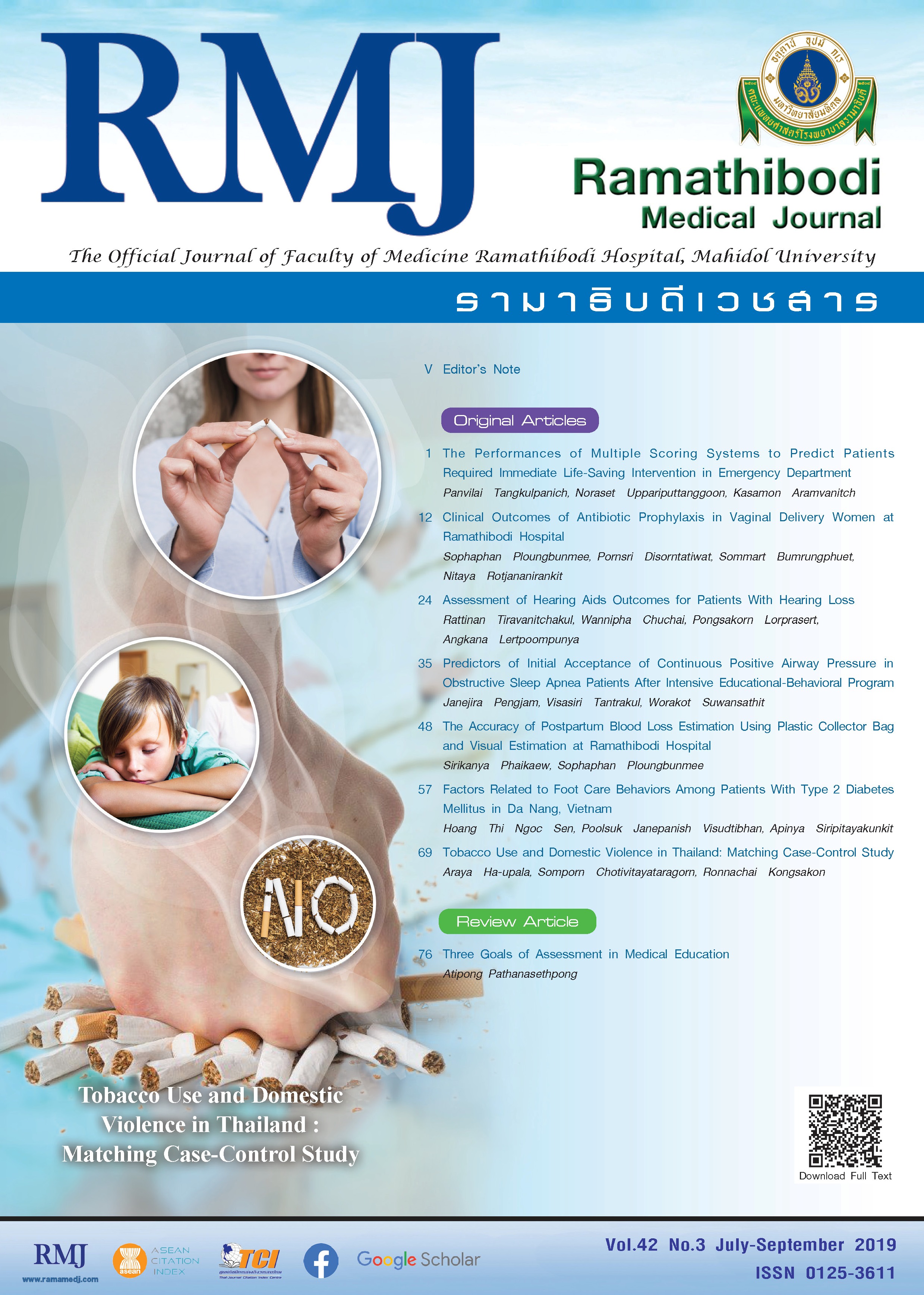Predictors of Initial Acceptance of Continuous Positive Airway Pressure in Obstructive Sleep Apnea Patients After Intensive Educational-Behavioral Program
DOI:
https://doi.org/10.33165/rmj.2019.42.3.175165Keywords:
Obstructive sleep apnea, Continuous positive airway pressure, Behavior modificationAbstract
Background: Continuous positive airway pressure (CPAP) device therapy is the standard treatment for obstructive sleep apnea (OSA) to date. However, acceptance and adherence rate remained low. Recent study showed that educational and behavioral modification program can improve the efficacy of CPAP use.
Objectives: To study rate of acceptance and its predictor factors of in patients with obstructive sleep apnea after participant in group modification behavior program.
Methods: This prospective cohort study was conducted in 247 obstructive sleep apnea patients at Ramathibodi Sleep Disorders Center, Ramathibodi Hospital from February to July 2015. There were indicated for CPAP. Participating states spanning included awareness, motivating, demonstration, and trials of CPAP evaluated every week for 3 weeks.
Results: Of 247 obstructive sleep apnea patients (62% male) were included with apnea-hypopnea index (AIH) (median [interquartile range], 41.5 [46.4]), and acceptance CPAP (85%). Factors influencing decision to use CPAP were severity of diseases (OR, 4.1; 95% CI, 1.2 - 13.9), triple trials (OR, 8.6; 95% CI, 2.1 - 35.4), and government reimbursement (OR, 8.1; 95% CI, 2.9 - 22.4).
Conclusions: After educational and behavioral intervention, the CPAP acceptance rate were high among Thai patients with obstructive sleep apnea. This program should be encouraged for more widespread clinical practice.
References
Somers VK, Dyken ME, Clary MP, Abboud FM. Sympathetic neural mechanisms in obstructive sleep apnea. J Clin Invest. 1995;96(4):1897-1904. doi:10.1172/JCI118235.
Kendzerska T, Mollayeva T, Gershon AS, Leung RS, Hawker G, Tomlinson G. Untreated obstructive sleep apnea and the risk for serious long-term adverse outcomes: a systematic review. Sleep Med Rev. 2014;18(1):49-59. doi:10.1016/j.smrv.2013.01.003.
Marin JM, Carrizo SJ, Vicente E, Agusti AG. Long-term cardiovascular outcomes in men with obstructive sleep apnoea-hypopnoea with or without treatment with continuous positive airway pressure: an observational study. Lancet. 2005;365(9464):1046-1053. doi:10.1016/S0140-6736(05)71141-7.
Ye L, Pack AI, Maislin G, et al. Predictors of continuous positive airway pressure use during the first week of treatment. J Sleep Res. 2012;21(4):419-426. doi:10.1111/j.1365-2869.2011.00969.x.
Neruntarat C, Chantapant S. Prevalence of sleep apnea in HRH Princess Maha Chakri Srinthorn Medical Center, Thailand. Sleep Breath. 2011;15(4):641-648. doi:10.1007/s11325-010-0412-x.
Suwanprathes P, Won C, Komoltri C, Nana A, Kotchabhakdi N, Guilleminault C. Epidemiology of sleep-related complaints associated with sleep-disordered breathing in Bangkok, Thailand. Sleep Med. 2010;11(10):1025-1030. doi:10.1016/j.sleep.2010.04.007.
Campos-Rodriguez F, Martinez-Garcia MA, de la Cruz-Moron I, Almeida-Gonzalez C, Catalan-Serra P, Montserrat JM. Cardiovascular mortality in women with obstructive sleep apnea with or without continuous positive airway pressure treatment: a cohort study. Ann Intern Med. 2012;156(2):115-122. doi:10.7326/0003-4819-156-2-201201170-00006.
Martínez-García MA, Campos-Rodríguez F, Catalán-Serra P, et al. Cardiovascular mortality in obstructive sleep apnea in the elderly: role of long-term continuous positive airway pressure treatment: a prospective observational study. Am J Respir Crit Care Med. 2012;186(9):909-916. doi:10.1164/rccm.201203-0448OC.
Campos-Rodriguez F, Martinez-Garcia MA, Reyes-Nuñez N, et al. Long-term continuous positive airway pressure compliance in females with obstructive sleep apnoea. Eur Respir J. 2013;42(5):1255-1262. doi:10.1183/09031936.00165812.
Martinez-Garcia MA, Capote F, Campos-Rodriguez F, et al. Effect of CPAP on blood pressure in patients with obstructive sleep apnea and resistant hypertension: the HIPARCO randomized clinical trial. JAMA. 2013;310(22):2407-2415. doi:10.1001/jama.2013.281250.
Sullivan CE, Issa FG, Berthon-Jones M, Eves L. Reversal of obstructive sleep apnoea by continuous positive airway pressure applied through the nares. Lancet. 1981;1(8225):862-865.
Sawyer AM, Gooneratne NS, Marcus CL, Ofer D, Richards KC, Weaver TE. A systematic review of CPAP adherence across age groups: clinical and empiric insights for developing CPAP adherence interventions. Sleep Med Rev. 2011;15(6):343-356. doi:10.1016/j.smrv.2011.01.003.
Weaver TE, Grunstein RR. Adherence to continuous positive airway pressure therapy: the challenge to effective treatment. Proc Am Thorac Soc. 2008;5(2):173-178. doi:10.1513/pats.200708-119MG.
Weaver TE, Sawyer AM. Adherence to continuous positive airway pressure treatment for obstructive sleep apnoea: implications for future interventions. Indian J Med Res. 2010;131:245-258.
Engleman HM, Wild MR. Improving CPAP use by patients with the sleep apnoea/hypopnoea syndrome (SAHS). Sleep Med Rev. 2003;7(1):81-99. doi:10.1053/smrv.2001.0197.
Sawyer AM, Canamucio A, Moriarty H, Weaver TE, Richards KC, Kuna ST. Do cognitive perceptions influence CPAP use? Patient Educ Couns. 2011;85(1):85-91. doi:10.1016/j.pec.2010.10.014.
Zozula R, Rosen R. Compliance with continuous positive airway pressure therapy: assessing and improving treatment outcomes. Curr Opin Pulm Med. 2001;7(6):391-398.
Lai AYK, Fong DYT, Lam JCM, Weaver TE, Ip MSM. The efficacy of a brief motivational enhancement education program on CPAP adherence in OSA: a randomized controlled trial. Chest. 2014;146(3):600-610. doi:10.1378/chest.13-2228.
Aloia MS, Smith K, Arnedt JT, et al. Brief behavioral therapies reduce early positive airway pressure discontinuation rates in sleep apnea syndrome: preliminary findings. Behav Sleep Med. 2007;5(2):89-104. doi:10.1080/15402000701190549.
Richards D, Bartlett DJ, Wong K, Malouff J, Grunstein RR. Increased adherence to CPAP with a group cognitive behavioral treatment intervention: a randomized trial. Sleep. 2007;30(5):635-640.
National Cancer Institute. Theory at a Glance: A Guide For Health Promotion Practice. 2nd ed. Bethesda, MD: US Department of Health and Human Services, National Institutes of Health, National Cancer Institute; 2005. https://cancercontrol.cancer.gov/brp/research/theories_project/theory.pdf. Accessed June 27, 2019.
Aloia MS, Arnedt JT, Stepnowsky C, Hecht J, Borrelli B. Predicting treatment adherence in obstructive sleep apnea using principles of behavior change. J Clin Sleep Med. 2005;1(4):346-353.
Colby SM, Monti PM, Barnett NP, et al. Brief motivational interviewing in a hospital setting for adolescent smoking: a preliminary study. J Consult Clin Psychol. 1998;66(3):574-578. doi:10.1037/0022-006X.66.3.574.
Trupp RJ, Corwin EJ, Ahijevych KL, Nygren T. The impact of educational message framing on adherence to continuous positive airway pressure therapy. Behav Sleep Med. 2011;9(1):38-52. doi:10.1080/15402002.2011.533993.
Budhiraja R, Parthasarathy S, Drake CL, et al. Early CPAP use identifies subsequent adherence to CPAP therapy. Sleep. 2007;30(3):320-324.
Smith I, Nadig V, Lasserson TJ. Educational, supportive and behavioural interventions to improve usage of continuous positive airway pressure machines for adults with obstructive sleep apnoea. Cochrane Database Syst Rev. 2009;(2):CD007736. doi:10.1002/14651858.CD007736.

















